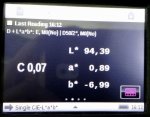In one application, which measures color with i1Pro 2 in scan mode, i'm getting strange results in paper measurement.
Same paper receives L measurement from 103 to 107, but the same paper in "measure tool", measured with same instument and measured with eXact (M0) receives same L 94.4-94.8.
So spectrophotometer is "ok", i guess.
Could "specular reflection" be responsible for L-values more than 100? If yes, could you explain theory behind this?
Same paper receives L measurement from 103 to 107, but the same paper in "measure tool", measured with same instument and measured with eXact (M0) receives same L 94.4-94.8.
So spectrophotometer is "ok", i guess.
Could "specular reflection" be responsible for L-values more than 100? If yes, could you explain theory behind this?












